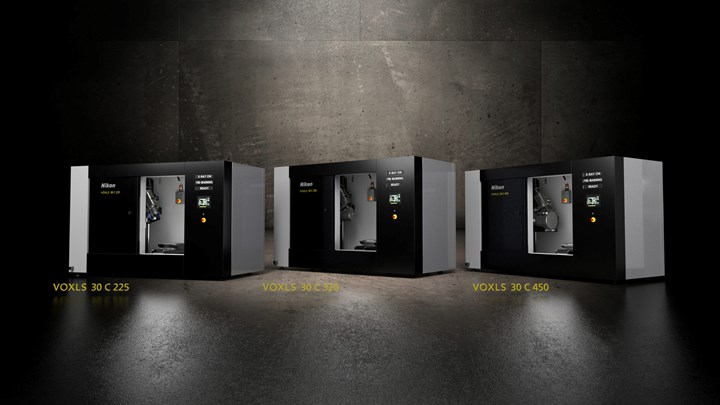Automation-Ready Nondestructive Inspection CT Systems
Nikon Metrology has launched VOXLS 30 C 225, 30 C 320 and 30 C 450 inspection models designed for automated operations across the production sector.
Nikon Metrology has launched three new models in its VOXLS range of X-ray computed tomography (CT) systems for nondestructive inspection. The 30 Series is designed for users looking for an automation-ready system with the versatility to meet a wide range of industrial applications.
The VOXLS 30 C 225, 30 C 320 and 30 C 450 models have maximum source energies of 225 kV, 320 kV and 450 kV, respectively, for examining parts of various densities and sizes. They also have a more compact footprint than Nikon’s 40 Series while maintaining advanced features traditionally exclusive to larger, more expensive solutions.
The systems are designed for automated operations across the production sector, especially for quality control. The automotive, aerospace, medical and pharmaceutical industries are additional target markets.
At the core of this series is a metrology-grade, granite-based manipulator coupled with rigid steel towers, which provides a thermally stable and solid construction. High-precision motors, ballscrew drives and encoders provide precise positioning and accurate movement of all axes, including the synchronous vertical motion of the X-ray sources and detectors.
The 30 Series systems feature extensive CT acquisition technologies and reconstruction algorithms, including X.Tend Helical CT, Offset.CT, Panel Shift, Pixel Split CT, Half.Turn CT and Tilted CT.
According to Nikon, the 30 Series’ 225 kV model offers an industry-leading scan volume within its size class, while all models offer maximum scanning volumes of more than 600 mm in diameter by more than one meter high.
The 30 Series cabinets utilize a manipulator-interlocked, glass outer door to give the operator visibility into the enclosure when the inner radiation safety doors are open. This design enables confident positioning of the scan object, minimizing the risk of collision with the X-ray source and detector while also providing a physical safety barrier between the operator and the moving manipulator. Multiple internal, high-resolution video cameras provide a view even with the inner radiation safety doors shut and X-rays on.
RELATED CONTENT
-
Quick Flow Analysis of Hot Runners
Quick flow analysis technology can improve the selection, design and troubleshooting of hot runner tools.
-
Technology Roundup: Mold Builders, Miscellaneous
Every month MMT compiles a list of industry-related products and services that will appear in its upcoming print issue. This roundup covers mold builders, hot runners, software and metrology products under inspection/measurement.
-
X-Ray CT Systems Meet Diverse Inspection Needs
The next-generation Nikon Metrology VOXLS family includes the large-volume VOXLS 40 C 450 that is available now and four medium-sized models coming later in 2023.













